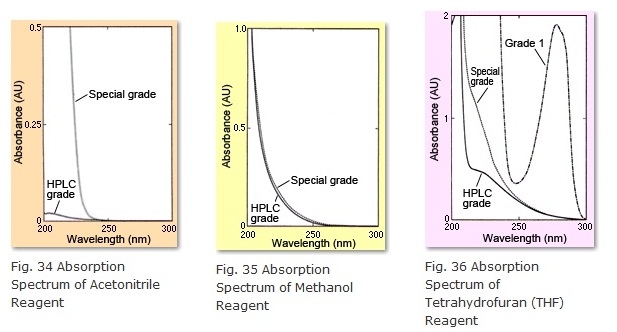6-1) How to Achieve a High Sensitivity Baseline for Reversed-Phase Columns and UV Short Wavelengths
Measures for Specific Analytical Conditions
Previous sections discussed the characteristics and applications for specific mobile phase degassing methods. This section considers them with respect to analytical conditions. In general, heated stirring (described in 5-1) and elevating the mobile phase (described in 5-6) is often adequate for normal sensitivity levels, but in many cases, such as if detection conditions differ or if stability of a high-sensitivity baseline is required, online degassing is necessary or other non-degassing measures should be considered.
How to Achieve a High Sensitivity Baseline for Reversed-Phase Columns and UV Short Wavelengths
Using an ODS or other reversed-phase column with a UV detector is the most popular combination for HPLC analysis. However, to achieve high sensitivity detection in the short-wavelength region, the following points must be considered.
(1) Thoroughly Rinse HPLC Flow Lines and Columns
Simply rinsing through the day with mobile phase is a waste of time. A more effective rinse method is to use a rinse solution with higher solubility than the mobile phase for the specific substances being rinsed. For example, to rinse out oil-based substances or highly hydrophobic neutral substances, try tetrahydrofuran. For substances adsorbed to the surface of silica gel, use a 0.01 % aqueous phosphate solution containing methanol/0.5 M sodium perchlorate (1:4). For metal ions, use 0.1 % aqueous EDTA-2Na (except not through the column). Rinse flow line switching valves, including injectors, several times by switching to each valve position. Rinse suction filters as well.
Flow line and column rinsing measures should also be considered for other high-sensitivity analysis in a similar manner.
(2) Using Reagents With Low Mobile Phase Background Levels
Figures 34 to 36 show the absorption spectra for acetonitrile, methanol, and THF reagents that are often used in mobile phases for reversed-phase columns. These show that LC-grade acetonitrile has the lowest background level in the short wavelength region. In contrast, methanol and THF reagents have the higher background levels which increases noise, and the background level varies in response to fluctuations in dissolved oxygen levels. Therefore, they are not appropriate for high-sensitivity analysis. Separation selectivity and peak shape can vary depending on the solvent type, but if the tradeoff is not too great, LC-grade acetonitrile should be used.
In addition, using acetic acid or another organic acid for a buffer solution or an amine-based adsorption inhibitor, such as triethylamine, can increase the background level. Use a sodium phosphate-based solution for buffer solution (and sodium perchlorate for adsorption inhibitors), and prepare just the necessary amount of mobile phase whenever required. For water, of course, use LC-grade distilled water.
(3) Using High-Sensitivity Detectors
Obviously, of the LC detectors available on the market, use one with as low a noise level as possible.
(4) Online Degassing
Even if using LC-grade acetonitrile, a sealed pressurized helium purging system or another type of online degassing system can provide a slight reduction in the background level.
We have only indicated four points above, in order of importance, but in actuality, it is most commonly points (1) and (2) that do not satisfy appropriate conditions. Therefore, consider analytical conditions as well.
(LC-grade distilled water was used respectively for air saturated and reference.)



